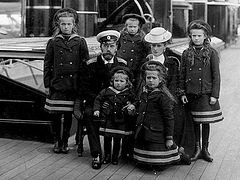Bishop Basil (Rodzianko) is one of the pillars of Russian Orthodoxy in the twentieth century. Not even the Soviet “jammers” tuned to the waves of BBC Radio could block the spiritual conversations by which he brought the word of God to his flock throughout the whole world for so many years.
He left Russia in infancy, though he carried love for it throughout his entire life, and as soon as the Iron Curtain fell, he immediately started visiting his homeland.
On one of the first such trips, in 1988, Vladyka unofficially served one of the first panikhidas for Tsar Nicholas II and his family in the USSR. It happened right on the 70th anniversary of their murder in Ekaterinburg, which I heard about from Vladyka’s spiritual daughter and assistant of many years, Marilyn Swezey, who was with him on that pilgrimage.
As she believes, the service became a kind of prologue to the glorification of the family and faithful servants of the last Tsar, which took place twelve years later.[1]
In the summer of 1988, Bishop Basil and a group of parishioners of our St. Nicholas Cathedral in Washington and other believers traveled to Moscow. It was one of the first pilgrimage trips to the Soviet Union.
On the plane, I realized that the day after our arrival—July 17—would be the day of remembrance of the Imperial Family. I went up to Vladyka and said: “Vladyka, we have to do something for this.”
He looked at me and said: “It’s impossible. I can’t do anything to make it official.”
We talked a little more, but since Vladyka was certain that nothing could be done, there was nothing more to discuss.
However, events began to unfold in an unexpected way. As soon as we checked in at the Cosmos Hotel, a very young Gosha Shevkunov, now Metropolitan Tikhon of Pskov, arrived. He and his friend had found out about our trip and decided to meet Vladyka.
They asked him to serve a panikhida the next day for the Imperial Family. “We can’t do anything, but you can,” they said, laying out their plan.
The state had just returned a small, wonderful church on the territory of the dilapidated Simonov Monastery to the Patriarchate, where they have the relics of Peresvet and Oslyabya—the heroes of the Battle of Kulikovo, whom St. Sergius of Radonezh sent to help St. Dmitry Donskoy. Gosha proposed that Vladyka go there the next day and serve a panikhida, first for these soldiers, and then for the members of the Royal Family, who at that time were not yet glorified by the Russian Orthodox Church.
Of course, we had to take every precaution. Don’t forget, the Soviet Union still existed then, and we couldn’t publicly mention the Tsar and his family, even during a service. In any case, we had to be careful that people from the KGB, who could be anywhere at that time, didn’t figure us out.
Fortunately, everything went well. Perhaps the authorities didn’t keep such a close eye on Bishop Basil because he was a visiting hierarch. Plus, the future Vladyka Tikhon and his friend had done a great job of organizing everything.
Our group included several choir members from St. Nicholas Cathedral, and we sang the panikhida that Vladyka served. Of course, there were other people nearby, but they didn’t pay much attention to us.
I think this panikhida was very important. Yes, it was an unofficial celebration, but, in fact, it was the beginning of the gradual recognition of the Royal Martyrs, which ended with their canonization in 2000 in Christ the Savior Cathedral.
We were already on our way back to the bus to go to the hotel after the service when Gosha stopped us and gave Vladyka two beautiful white ribbons with the names of every member of the Royal Family written on them in gold. He said: “We can’t keep these here, but can take them with you to Washington, Vladyka.”
So Vladyka took them with him, and he kept them in a prominent place in his home chapel.
I now have these ribbons at home, together with several other items from Vladyka. I took them when we had to clear out his apartment after his repose, and Metropolitan Jonah (Paffhausen) kept the portable altar, the small royal doors, and other liturgical items. Now they’re at the St. Demetrios of Thessaloniki Skete that he founded outside of Washington. We’re thinking of setting up a small space there dedicated to Vladyka Basil, and partially recreating his chapel, with his desk and his books. These ribbons with the names of the members of the Imperial Family will be there too.







